This article contains expert-led insights from a previous season of the Million Dollar Case Study.
MDCS is a free, comprehensive video series by Jungle Scout in which veteran Amazon sellers show budding entrepreneurs how to succeed on Amazon—by actually doing it. The series takes viewers step by step through the process of launching a real product on Amazon in real time—from product research to finding a supplier to advertising.
Check out our most current season here for the latest information on selling on Amazon.
This is it… when the rubber meets the road, the pen to paper, final decisions on our supplier are made. This is a super exciting session of the Million Dollar Case Study, where we will cover our negotiations with suppliers, final evaluations, and contract.
Hopefully you have been sticking along with us as we continue progress forward week after week. Definitely stick with us through until the end (at least the end of the post) as we have an exciting announcement, and of course the helpful templates and resources to help launch your own Amazon business!
Here is the full video replay:
And the accompanying slides:
Quick Recap On Our Progress Thus Far…
One of the most important lessons that I’ve learned launching a product with Greg is the value of execution. Week after week, we continue to make progress towards finding and launching a product. There have been unforeseen challenges and it does require a bit of work and discipline to maintain the momentum, but as verified by our current state of affairs (about to place our order), it has been well worth it!
Here’s where we are now:
- We have done a few weeks of product research and validation using Jungle Scout to track potential products.
- Found suitable suppliers
- Decided on product specifications that will help us stand out
- Ordered and reviewed samples
- Set up VAT & EORI
- Made product branding decisions
- Set up a Seller Central Account and Product Listing
And this week, we will review our final product specification and supplier agreement!
A Review Of Our Suppliers
So we narrowed down our choice of suppliers to three options, which we found on Alibaba. And as you might imagine, there was a range in the quality of product, interactions, and responsiveness with each.
I summarized the experience with each in the following notes:
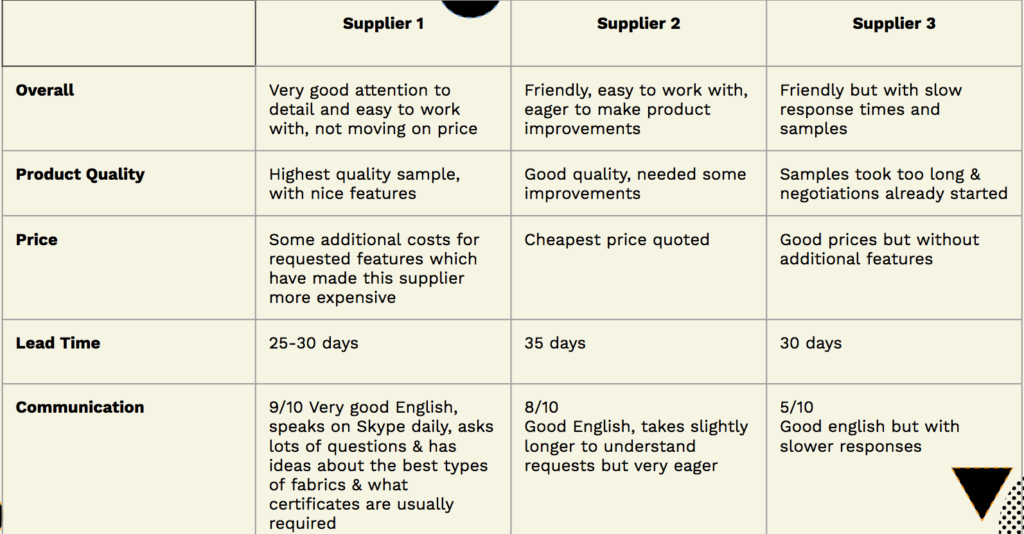
Here are my thoughts, in brief:
Supplier 1:
A solid product sample, in fact, the best that we received. The pricing was a bit higher than others, but they had the shortest manufacturing lead time and excellent responsiveness and communication skills.
Supplier 2:
A good quality product, with a few minor improvements that we identified. They quoted the cheapest price, had good communication skills, and were cooperative in working with us and making suggestions on product improvements.
Supplier 3:
Thanks, but no thanks. They had slow response times with communication, and executing on some of the early prerequisites—for example, we haven’t even received our sample yet! To me, this is just an indication of future potential problems, and I think it’s best just to omit them from the final shortlist.
A Review of the Samples
I love this part, literally pulling the product apart at the seams and imagining how we would feel if this were our product.
If you remember from Session 5, we put together all of our product specifications that we wanted. It looks like this:
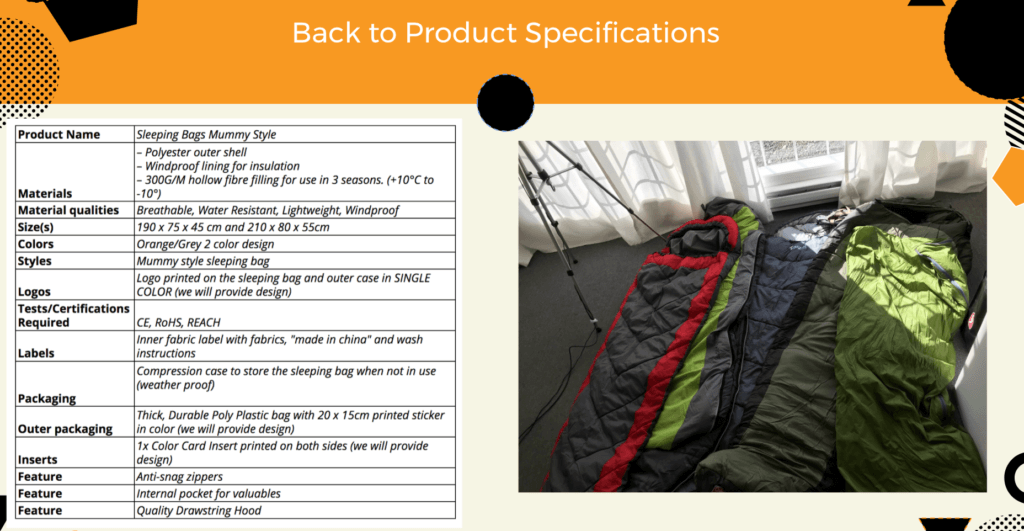
So we tinkered with it in a rather rough fashion, as we imagine an actual customer would if they were to take this product on an overnight hike.
We used the compression bag that holds the sleeping bag as a proxy for product quality.
So what happened when we did that?
One of the bags just broke. ;-( This is definitely not the user experience that we want to offer. However, as Greg noted, this is not necessarily a deal-breaker for working with the supplier, but instead is just a constructive lesson that we can use in communicating with them, that we expect a strong compression bag to hold the sleeping bag.
One of the suppliers sent a sample that had canvas straps that reinforced the bottom. This is the type of small detail that connotes craftsmanship and quality that we want to have in our final product, so regardless of the final supplier, we will want to take photos of this detail and include it in our final product specifications.
In the video, I showcased one of the nice samples that we had—it had nice colors, nice stitching, a pouch inside to store a phone in, and it was lightweight to pack down into a compact package without sacrificing warmth. A few details that we were able to identify that needed improvement in the actual production is a slightly different color, an anti-snag zipper (a snagged zipper is a terrible thing to have!), and a high-quality bag with product inserts, labeling in the sleeping bag, and a few other details.
If you want to see some of the other product packaging details that we discussed, please check out Session 7 on Product Packaging and Branding.
Negotiation Tips
I want to share a few takeaways that I had while negotiating with the various suppliers. The goal in my mind with these negotiations is that both parties, both us and the supplier, feel happy with the final deal. If we can establish a mutually beneficial long term business relationship with this first negotiation, then it’s a win!
Greg suggests putting yourself in the supplier’s position when negotiating. Focusing on the long term relationship and consistent future growth together can go a long way in establishing a fruitful and collaborative relationship from the start.
1. Ask for a quote at different MOQ’s and/or different specifications.
Once you get an idea of what the different unit costs are depending on how many units are ordered, you have a little wiggling room and understanding on how the pricing can fluctuate with quantity. This is helpful, so that we can home in on a cost that works for us, while also ensuring that the suppliers are ultimately happy with the final negotiated price.
2. Play Up A Bright Future
As any entrepreneur knows, optimism is a critical component to keep pushing through, especially when things are challenging. And we certainly want to
3. Explore Different Packaging Options
The packaging options and various product specifications that we opt for can impact the product costs and obviously our profit margins. It has been helpful to hear the different suggestions and capabilities that the suppliers have offered for our packaging and compression bag.
4. Pitch Against Competitors
Now that we are narrowing down our final choice for a supplier, we can use the pricing and information that we have gathered to leverage our own negotiations. Meaning, that we can go to one supplier and note that we are getting certain product offerings or prices, and see if they can match or beat the offer.
In the end though, we just need to pull the trigger. If we have found a product cost for the exact specifications that we want, we will just have to move forward to get this product launched!
Deposits And Payment Terms
Now let’s talk money. It’s all about the Benjamins, at least in America, right?
The first rule as far as deposits is simple: don’t pay 100% of the costs upfront. This will leave you with no leverage if you need to negotiate in the future, like if you are not happy with the product quality or delays.
What is more typical is either 50/50 or 30/70, as in pay 50% or 30% of the total cost as an initial down payment, then pay the balance upon successfully completing the production run and passing inspections. Obviously, the larger the order quantity and cost, the more negotiating power you have in having a lower upfront cost.
As far as payment methods, T/T, also known as a wire or bank transfer, is typical.
A new offering as of a few years ago is Alibaba Trade Assurance, an Alibaba escrow service that holds the money until successful completion of the manufacturing order, at which point Alibaba pays the suppliers. Not all suppliers are associated with using this service, but it is a nice assurance for those who feel uncomfortable about sending money via wire transfer for a first transaction.
The Purchase Order Agreement
We have shared the purchase order agreement that we’ve used previously, but don’t worry, you can get our latest version in this week’s homework. See, homework is a good thing!
In our purchase order agreement, you will see that we include the following:
- Full product specifications
- Product Costs
- Production time, agreed upon by both parties
- Inspections and processes for defects
- Packaging and labeling required
- Shipping agreement – who takes on responsibility at what point?
- Confidentiality agreement – a clause that the supplier can’t/won’t discuss the product, brand, or business with others.
>>Download your copy of the agreement here.<<
When putting this purchase order agreement together, I was very careful to put as much detail, in writing. We did a lot of work upfront to figure out exactly what the product specifications are, and we are going to market these features to stand out from the competition, so we certainly need to make sure that the supplier is aware of these to meet our standard!
A few things that we have also included to create a level of accountability:
- A monetary penalty: if the product doesn’t ship within a certain amount of time. For example, assuming that we agree to 30 days to manufacture, then we will allow a 7 day grace period, and thereafter the factory will pay a small percentage penalty for any subsequent delay in getting the product shipped.
- Inspection Failure: we include a note that if the supplier fails the first quality inspection, that they will pay for the second inspection.
- Must send photos at every stage of production: the chance to speak with the supplier and get updates at a frequent ongoing basis. A nice security and reassurance that the product is being manufactured and to the specs that you asked for.
Shipping – How Will We Get Our Product Where It Needs To Go?
For the purposes of this case study and keeping things moving at an accelerated pace, we are sending our first batch of product via Air Express. The remainder of the first order will be sent via ocean cargo. As you’d imagine, while we are getting the product to Amazon in a shorter time, we are paying more for the shipping, so will see lower profit margins in the beginning. But this is only for a small portion of the inventory order to get the wheels in motion!
We will need to send some details to our supplier to get the shipping taken care of properly.
Shipping Marks: These are the specific labeling details that go on the Master crate. For example, this information includes the case quantity, country of origin, the box weight and dimensions, different sizes, and colors (if applicable). This is helpful if the carton gets lost, so it is easier to track down.
Creating A Shipment Plan
After the goods are made, then what do you do? This is an important step for every Amazon seller, and it can be slightly confusing, for those going through the process for the first time.
If you have any questions about this part, it is very helpful to see how Greg creates a shipment plan over his shoulder in the replay of this session.
Once you go through this process, Amazon will tell you exactly where you need to ship your product, and what labels you need to use in order to get it there.
You will want to give the labels to your factory so that they can add it to the carton. From there, your freight forwarder will ship the product from China to the UK (or your chosen destination).
If you are sending by Air, like we are for our first few units, then you can essentially skip this step as DHL will ship your products directly from the factory straight to the Amazon distribution center.
Here is a step by step look at how the process works:
In Seller Central, go to “Manage Inventory”, then go to your specific product listing, and “Send/Replenish Inventory”:
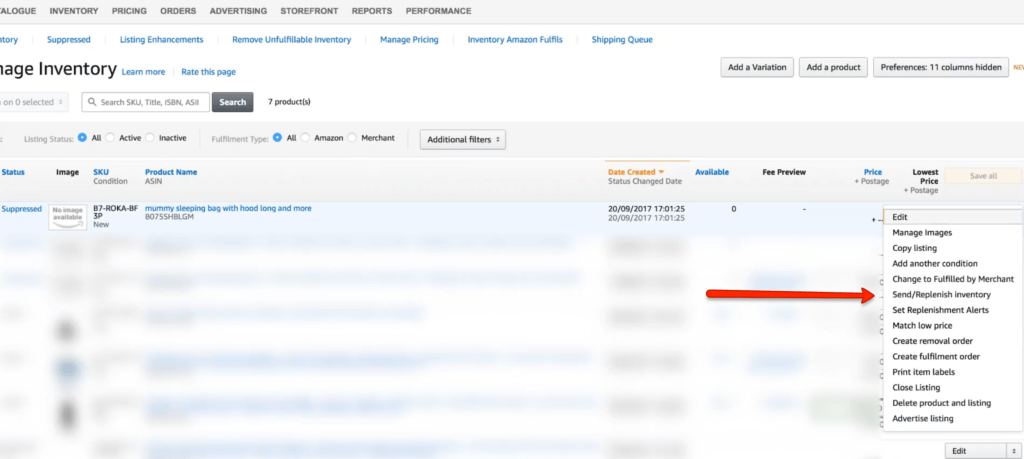
Then “Create A New Shipping Plan”:
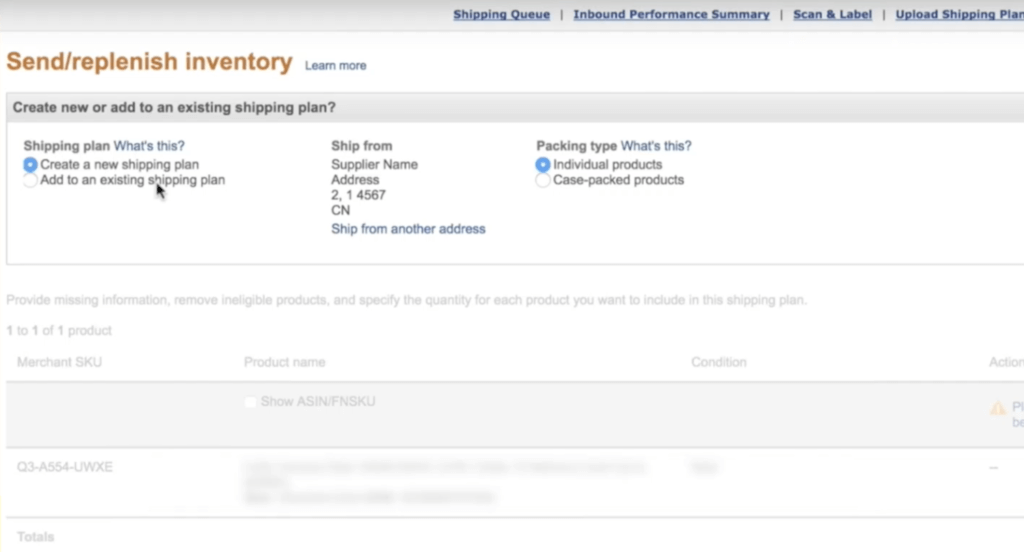
Then choose your Marketplace destination, for us is the United Kingdom. The “Ships From” address needs to be the address of your freight forwarder because that is where the trucks go to pick up the pallets (this section does not apply to you are shipping from China, by Air like DHL or UPS in which case you can just put any address):

For the “Item Pkg Type”, we chose “Case-packed items” because each case will have a bunch of the same item (ie our sleeping bags). We will need to enter the “Units per case” and the “Number of Cases”. At this point, it will be 10 sleeping bags per case, and 10 cases total. So 100 sleeping bags. Also, just for this first shipping order, Amazon requires that you enter the package dimensions, which are 25cm x 33cm x 25 cm:
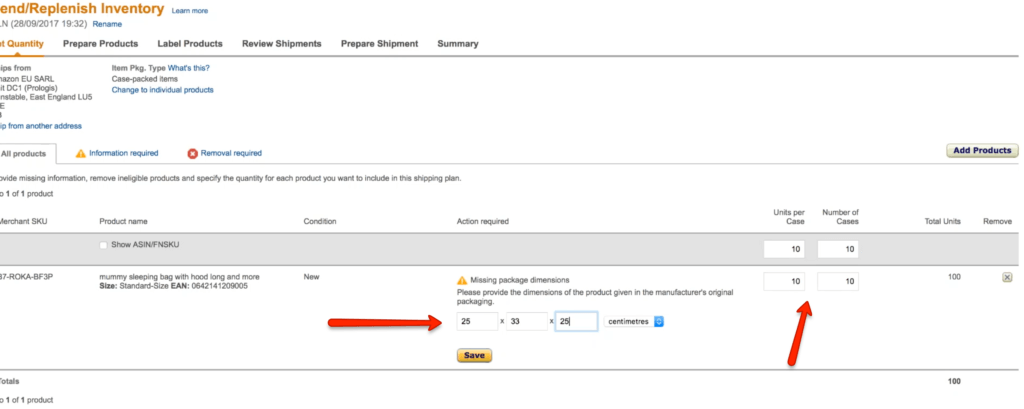
For this shipment plan, everything is going to Staffordshire, about an hour away from the place I called home growing up! At this point, I can “Approve Shipment” to access the shipping labels that I will need to send to our supplier:
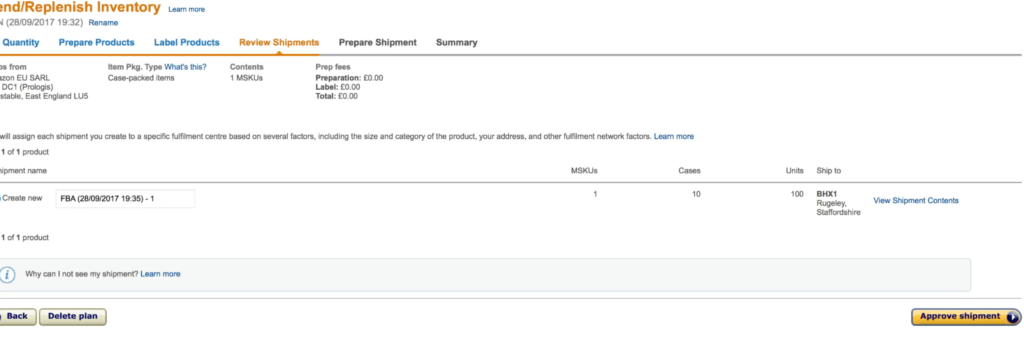
About Preparation
We don’t want Amazon to do any of the prep, instead, we will do this. So “Seller” prepares it. This refers to applying the labels, or if the product needs to be wrapped in bubble wrap. …the freight forwarder or the factory is going to do this, not Amazon. If you remember from our Product Branding session, we are printing the FNSKU directly onto the packaging. Alternatively, but not recommended, you can have your supplier add the stickered FNSKU to the product packaging, or Amazon can also do that for a nominal fee.
It is at this point that we can “Print Labels” for this shipment:
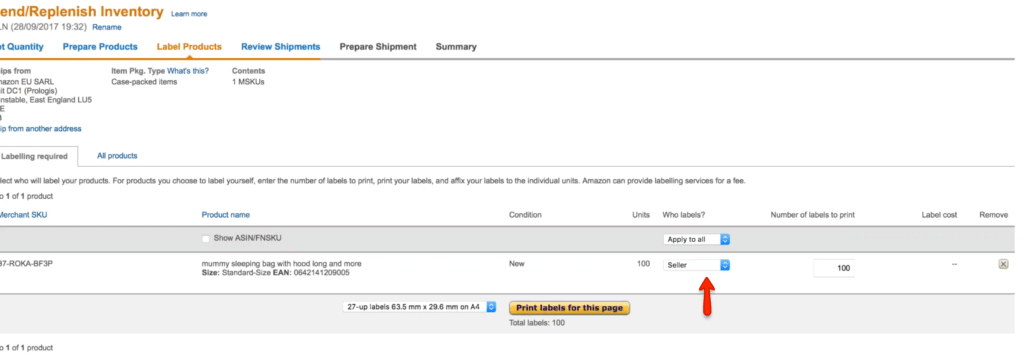
Here is the screen you see when you are “Working on the Shipment”.
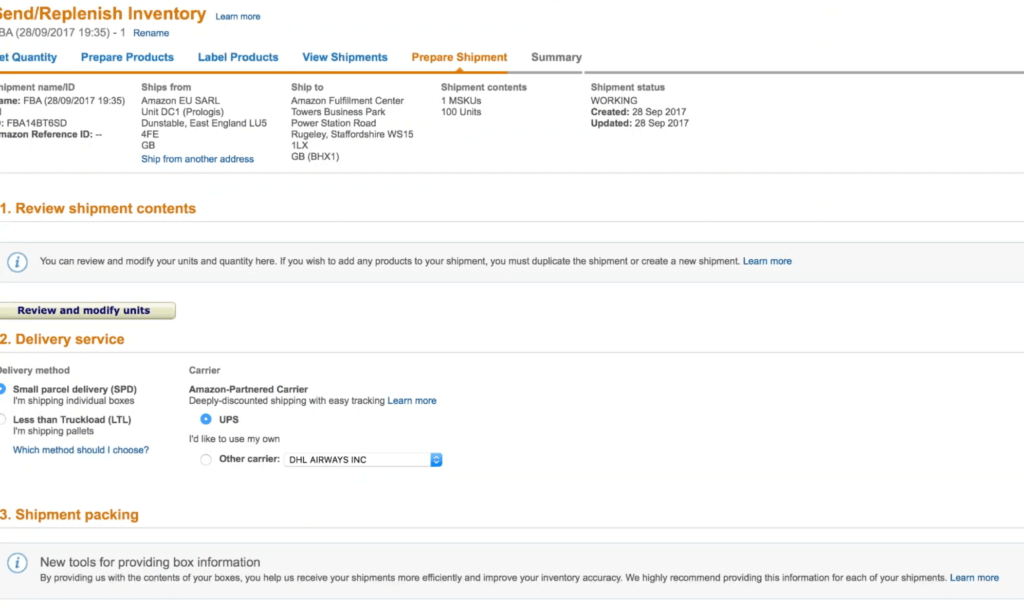
Options for Delivery service
Small Parcel Delivery – If you are shipping individual boxes, which is more common for air freight. Basically, each “individual box” would contain 10 of our sleeping bags, and we would ship these boxes into Amazon via air freight.
Less than Truckload – If you are shipping pallets. This is more common if you ship ocean freight. In this scenario, or product arrives by ocean freight to our freight forwarder, they put our products into pallets, and then send those pallets into Amazon’s distribution centers.
You will want to figure out what your delivery method will be, so that you can send the correct labels to your factory!
For our first two cartons that we are sending by Air, I will choose Small Parcel Delivery and “Use My Own Carrier”, which will be DHL. Often the supplier will have cheaper rates than what you can get on your own, but you still need to get these shipping labels and send them to your supplier, as Amazon uses these labels when receiving packages to know the product, sender, ASIN, etc.
For the second batch of sleeping bags that we are sending by ocean freight, we will choose the Less Than Truckload (LTL) option. In this case, the shipment arrives at our freight forwarder’s warehouse, where it is put on a pallet and sent to Amazon’s distribution centers.
Simply put, Less Than Truckload takes longer (pallets are not delivered with the same frequency as small parcel packages).
You can create these shipments at any point in time, they do not expire. In fact, it is best to create them in advance, so that you can get the necessary labels to your supplier and freight forwarder with ample time so you don’t waste any time once the manufacturing is complete.
One more thing to think about…when you place your order with your supplier, you will need logo designs, packaging labels, insert designs, fabric labels, label contents, and wording, etc to pass along. I am working to finalize these in the meantime, and I recommend you do the same, as it may be a bottleneck in your production.
Your homework
What would a Million Dollar Case Study session be if we didn’t have homework to keep you moving along with us?!
So here it is:
- Place your deposit and get the inventory ordered
- Ensure that you have negotiated the best prices and the most mutually beneficial contracts and agreements
- Continue to keep constant contact with your chosen supplier throughout the manufacturing process, ask for photos and updates frequently!
If you want to access the latest template, with a complete Purchase Order Agreement template, you can find it here:
www.junglescout.com/session10-HW
Oh and hey, we placed our deposit last Thursday! I plan to communicate frequently with the supplier, get frequent photo updates and as many fun tidbits as possible that I will be sure to pass along.
In the next session, we hosted a live Question & Answer session with Greg where we took questions from YOU before and during the session. Check it out here!
That’s all for this week, thanks for joining us. If you are following along with me as I launch a product, let me know your progress and thoughts in the comments below.
Subscribe to the Jungle Scout YouTube channel for the best insights every week:
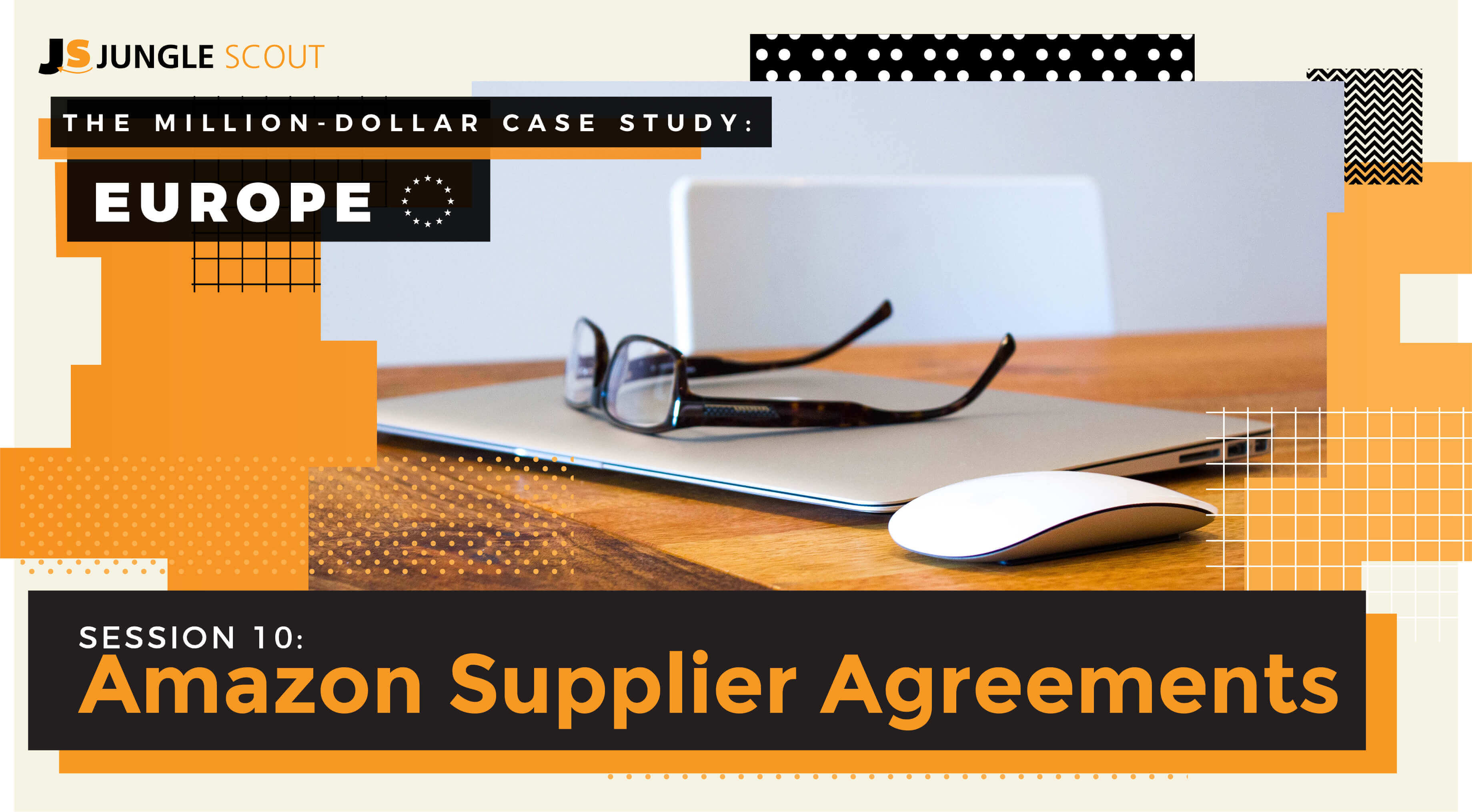

 47 Comments
47 Comments
47 comments on “The Million Dollar Case Study: Europe – Session #10: Amazon Supplier Agreements”
Hello, I know this is a late post to this blog date. One thing I am confused by, should the PO contract not be done before goods production?
The way this flow is laid out says, get the PO contract done (which states the address in which the shipment is to be delivered) but how do I get this address if I have created the shipment plan in Amazon yet?
The next step after the PO contract is where you show us how to create a shipment plan. It says, create plan once the goods are produced. How can they be produced without signing a PO contract first as this states once goods are completed, and also the fact, how do I get an address written in the contract when I won’t know it? Correct me if I am wrong, but when I create a shipment plan, the destination can be different every time and is determined by Amazon.
Can you please clarify what order we do this?
Thanks,
If you are sending by Air, like we are for our first few units, then you can essentially skip this step as DHL will ship your products directly from the factory straight to the Amazon distribution center.
On Amazon page they say : Sellers with shipments that originate from overseas will need to arrange the import and customs clearance of the shipment, and then arrange for the delivery to our facility. Amazon may not be used as the consignee, importer of record or final address when shipping from overseas.
I am a little confused here, can i ship my products directly from the factory straight to the Amazon distribution center or not? I mean for Air Shipment, Small Parcel Delivery.
Thank you!
Purchase Order Agreement template doesnt work any more can you guys fix it pls ?
Hi there, thanks for drawing our attention to this!
I have updated the link but you can also access the template here. Just make sure you’re on the correct tab for this session, this sheet includes the homework for every MDCS Europe session.
hope that helps!
Melissa
Why it isn’t recommended that the supplier will print my FNSKU’s?
I’m not sure why in Rolando’s experience, but personally, I’ve never had an issue with this. I will note, however, that I usually forego fnSKUs for a UPC on the packaging.
Questions for Kym:
1) Did you to a third party inspection and if so what was the costs?
2) Why did you have the confidence to ship directly from the supplier to Amazon in lieu of to you initially?
3) In your estimation what would be the additional costs per unit when it is shipped to you first in lieu of directly to Amazon.
4) Why do you request for EXW costs when you know you are going FOB. Is there a psychology involved to give the impression that you are not a neophyte?
5) What were the total costs of the three samples?
Thanks,
Hi there , I sent the agreement order to the supplier I have chosen. And he doesn’t agree with the term concerning the 5% discount .
I loved the communication with the agent, she is so proactive and seem to understand what I really want, compared to other agents I have been talking to.
Do you recommend to go further with this supplier? Everything else have already been discussed, and i am really satisfied about everything else.
It seems to me that not accepting this term shows that the supplier will probably not be able to finish the production on time….
Hi Kym,
We have the signed Purchase Order Contract from our supplier. We’d like to place the order through Trade Assurance on Alibaba and attach the contract within the TA interface. Our supplier does not want to use TA although it says they are a Gold Supplier and have TA with 10 years on Alibaba. We are wondering if this is a red flag and what you would recommend?
Thank you,
Jessica
Hello – for the shipping address, do we put the port or the warehouse/trailer the packages will be taken to before the Amazon warehouse. My supplier has freight forwarder for me because we are doing DDP.
Download link for agreement does not work…;-/
Thanks for letting us know Karl – looking into this. In the meantime you can review the whole series’ worksheet here: https://docs.google.com/spreadsheets/d/1IASyEtl0QYcTtMXkzbmkyRzXj4UvAv6lYa3hl2EJmjc/edit?usp=sharing
Simply navigate to session 10 for this particular agreement template.
Many thanks,
Kym
Hi Dave,
I’m still getting the 404. Is it still broken?
Hey Glen,
Apologies – looks like this one was still broken. It should be fixed now, I just tested it myself.
Here’s the direct link if not: https://docs.google.com/spreadsheets/d/1VnabyBtP4w9huqy-a_p1rgNhnAuCar7tRRxT9wu1OkQ/edit?usp=sharing
Many thanks,
Kym
Hi Kym,
Thanks for this! This is great. The link to the agreement is returning a 404. Anyway you can update the link?
Hello!
The links were temporarily disabled because of a link migration and should work now.
Hi,
http://www.junglescout.com/session10-HW seems to be broken. Can you tell me where can i find the complete Purchase Order Agreement template please 🙂 ?
Hello!
The links were temporarily disabled because of a link migration and should work now.
Whoops sorry – temporary error, you should be able to access this from the link on the post now 🙂
Tahnks a lot :).
hi Kym and good luck with your product.
My first product is in production another will be shipped to Amazon with in a month.
With your permission I have two questions about the shipping plan:
1. When I have variations, do I use the same shipping plan for all of it, and how do I define the amount of cartons for each variation.
2. In order to get Amazon’s warehouse address, I have to fill in the shipping plan the address of the of the forwarder’s warehouse.
And in order to get a quotation from the forwarder I need Amazon’s warehouse address.
What comes first ???
Thanks in advance
Erez
Hey Erez,
You can use the same shipping plan for multiple SKUs or variations. You would do this as a combined shipping plan, so create a shipping plan for one variation first and then add more variations to the same shipping plan. You can specify the amount of cartons for each that way too.
If you already know which forwarder you are using, then you can ask them for an address to use. They will give you a warehouse address in the country you are shipping to. Then when you create the shipping plan, you will have the Amazon warehouse address(es) which you can give to your forwarder.
I actually created a quote with Flexport before I created a shipping plan, and then updated them later on which UK Amazon warehouse it was going to and they updated my order from there.
Hope this helps 🙂
Kym
Hi Guys,
Hope this message finds you well.
I have a few quick questions, if possible.
If I ask for a FOB quotation and the supplier agrees on, in the purchase agreement at the shipping terms I should include something like “The second party agrees to deliver the goods to the freight forwarder named as “…” situated in “address of the port” …
One more thing when I ask my supplier for the FOB, is it normal to ask them not to palletize the goods, so I will not pay for the extra weight? will that be a problem with the freight forwarder?
Thank you in advance for the advice.
Kind regards,
Sorin
Hey Sorin,
Thanks for joining the case study – those are excellent questions.
It is a good idea to work that into your agreement. Usually, your supplier would inform you which port they will deliver the goods to in China, as part of your FOB agreement. Then you would tell your forwarder to collect from that port. In my experience this always works out fine, even if you don’t know which forwarder you will be using yet. If your forwarder wants the supplier to deliver to a specific port then that is something you will have to discuss between your supplier and forwarder.
And secondly, yes usually you would send the goods unpalletized to save on costs. Your forwarder will usually palletize the goods at the destination port prior to trucking to the Amazon warehouse.
Hope this helps 🙂
Kym
Hi Kym,
Am I correct in assuming you create your shipping plan/create labels prior to even placing the production order with your Alibaba supplier?
I ask because when you place an order using Trade Assurance it asks for your shipping address upfront which obviously Amazon needs to provide to you.
Thanks
Hey Ty,
Good question. I actually didn’t – because we had some holdups with waiting a few weeks for Amazon to approve therefore I had no way to set these up before placing the production order.
However, you absolutely can set up a shipping plan at any stage and it’s great if you are thinking ahead like that 🙂
You can also use your freight forwarders shipping address in the case that you don’t know which Amazon fulfillment center you will be sending to yet.
Hope this helps & thanks for joining the case study!
Kym
Hi Kym,
I am ordering my units from China to be sent by air to Amazon FBA via DHL. Do I still need to provide shipping labels to my supplier to put on each carton? You mentioned above this is not needed as it can be any “from shipping address” if doing via air express. I just want to confirm if I still need to provide them with these shipping labels to put on each carton regardless of which “from shipping address” I put on there? The “To Shiping address” will be Amazon FBA warehouse.
Looking forward to your response,
Thanks!
Zeeshan
Hey Zeeshan,
Thanks for joining the case study 🙂
I just set up some air shipping for my product actually.
Here’s what I did:
1. Set up a shipping plan in Seller Central (see this walk through here: https://www.youtube.com/watch?v=OTni8bLLr2w&t=1112s)
2. Ensure you select case packed products since you are sending cartons, and enter your case quantities
3. Enter if you or Amazon will label the products (this is if you want Amazon to attach FNSKU barcodes to the products themselves, and you will need to do this if your supplier has not done this for you)
4. Once you approve the shipment, select the “Small parcel deliver (SPD)” method
5. Then you can select your units per box and print the carton labels. You will need to give these labels to your supplier to attach to the cartons for your delivery.
The from shipping address can be your suppliers warehouse address, which they can provide you with 🙂
Hope this helps, make sure to check out the video for a visual guide!
Kym
Hi Kym,
Question about shipping marks on outside master carton.
Apart from you mentioned in the article, would you recommend also putting Amazon seller name on the box and/or manufacturer’s name?
Hey Ty,
You will need to download shipping labels from inside seller central when you create your shipment plan.
You can read all about the requirements on this Amazon help page – this is for the US but I believe to same applies in any marketplace. The same with this in-depth guide here.
Also see here for an instructional video on how to create a shipment plan in Seller Central.
Hope this helps!
Kym
Hi Kym,
Do you need to put your legal company name on all these documents (i.e. purchase contract, supplier proforma invoice etc…) or can you just use your Amazon seller (display) name?
You guys use Jungle Creations which I believe is your Amazon seller name on your purchase agreement.
Does it make any difference to Amazon when they receive the product what name is on the shipping documentation?
Thanks.
Hey Ty,
Good question – I think it’s totally fine to use your Amazon seller name. At least we haven’t had any issues for this case study 🙂
In terms of the shipping documentation – you will need to create a shipping plan inside Seller Central, where you can download shipping labels. Between this and working alongside your supplier and Freight Forwarder, your shipment will definitely be received by Amazon perfectly fine. The main thing is to ensure that your products all have the FNSKU printed on the outer packaging!
Hope this helps
Kym
Hello,
At what point in the process do you actually pay the 30% to get the order started?
Is it after you draft the purchase agreement and get it signed off by the factory?
To expedite things does it make sense to pay the 30% upfront (assuming the major key points are agreed upon) and follow up with the purchase agreement after the fact?
Hi Ty,
Usually you would finalize the purchase agreement *before* paying your 30% deposit. The manufacturing process won’t start until you place your deposit, but it’s really important to make sure both parties agree on all of the terms required before you pay up. As explained in this session, you can add terms such as the supplier has to replace any items that are not found to be up to standards in a quality inspection. Or that you get a % discount for every week your inventory production is delayed.
If you don’t get these things ironed out before you pay, your supplier does not need to agree to any of these special terms.
It’s also worth saying that the template we used is one of Greg’s that he has compiled from years of experience as a seller. If you wanted to be extra cautious you could seek legal support for this part of the process. However, we have found that suppliers tend to take our agreement template very seriously and will ensure they agree to everything before signing.
Many thanks,
Kym
Hi Kym,
Thank you for your reply.
It shows how important it is to choose the right supplier, not only based on price and quality.
Thank you for your work.
Yoann
Hi Yoann,
Definitely – this is something I was really nervous about when I started, but I actually really enjoyed forming a relationship with my supplier in the end and by using my intuition and the signs the suppliers were giving me I was able to pick wisely.
Thanks for joining in the conversation 🙂
Kym
Hi Kym, JS team,
I have been selling PL products in Europe for 6 months now and I have 2 products online. I have reading your MDCS over the week end to catch up, it is really full of useful information and it is interesting to see how other seller work.
I am interested in and curious about your purchase agreement. Do you really think such a document offer you a good protection in case of problems or delay. As you mentionned in previous post, you are a small amazon seller working with a big manufacture. How will you react if there is a problem in their production line causing important delay for instance. They can say that they wont ship your order until you have paid the remaining 70% and they dont want to hear about penalties even if they agreed about before. I guess for them not having the rest of your money is not a big deal they do have other client , but for you you can loose 30% of your order, and all the efforts and work you have accomplished so far, because i don’t think you are going to sue them, even if this pruchase agreement could be in your favour in case of action in justice. I usually send also a purchase agreement but more to be used as a guideline for production.
I think one important aspect working with your supplier is trust. How will you react in case of this situation?
Thank you
Yoann
Hi Yoann,
Thanks for joining us, glad you are finding it useful 🙂
It’s a good question and in short, the purchase agreement we used is the same one we have used for all of the case study products. We haven’t had any issues so far, but it’s not a legally approved document, just something Greg put together from experience.
From my experience working with my supplier though, I found that they were very thorough with ironing out every last detail in this agreement, especially when it came to penalties for late production. This suggests to me that they take the agreement seriously and that we both have a mutual understanding of proceedings. They even signed and stamped the agreement, which is very formal.
If something did happen and there was a delay and they refused the penalties or to send stock until you paid the rest of the money, at this point you would probably want to cut your losses, pay up, get the inventory in and then find a new supplier. This would be a considerable breaking of trust.
Of course legal action is possible (as is getting a legal representative to draw out your agreement in the first place), but as a new seller it’s highly unlikely you’d want to go down this route.
Trust is definitely important and part of the learning curve as a new seller is how to form trusting relationships with suppliers 🙂
Many thanks,
Kym
Thanks for awesome tutorials. Excellent job! I have followed along and almost finalized on a supplier. While drafting the purchase contract, I have some confusions about the shipping and payment sections of the template.
1. it is expected that the Second party deliver the items to {INSERT ADDRESS HERE]. Is the address here FBA warehouse address? I haven’t created shipping plan in seller central yet. Does it mean I have to do it before signing purchasing contract with the supplier?
2. 10 cartons, express (2-4 days) – $XXX EDIT AS REQUIRED. Is the dollar amount here shipping cost or cost of goods? If it is shipping cost, which means I have to sign up with freight forwarder first, which I haven’t got there yet.
3. Shipping fee’s ($XXX) will be paid with final payment, after the goods are ready at shipment.
a) To get the exact shipping fees, I assume the freight forwarder will need such information as box dimensions and exact weight, which are not available until the products are made and packed. The supplier might be able to give an estimation, but it is just an estimation. How do you get the exact shipping fee to put in the contract?
b) Isn’t the shipping fee paid to the freight forwarder? why put it into the contract with the supplier?
Would appreciate if you could clarify.
Mike
Hi Mike,
Awesome, congrats on getting this far.
1. If you are going with FOB terms, then your supplier should get the goods to the port in China, and from there your freight forwarder will take over. However, you do need to create a shipping plan in Amazon in order to get the correct labels for the cartons etc. Find more information about shipping in Session #9 and creating a shipping plan is covered in this session 🙂
2. This is an option you can use if you want to express ship a small amount of inventory (and ocean freight the rest). You can do this if timescales are tight and you want to get launched (we are doing this with the sleeping bags). In this case, express air shipping can be done via DHL or courier so you can get the price directly from them.
3. Again it depends on what you have agreed with your supplier, this agreement is just a template to help people out with different circumstances. You can remove this if it does not apply to you and you are using FOB terms and letting your freight forwarder handle it from there. However, for us, as we plan to express air ship a small amount, we will pay that shipping money to the supplier 🙂
Hope this helps & good luck in on your journey!
Kym
Hi there, my goods have just been shipped by ocean to the US. Even if I printed the FNSKU directly on the product packaging I realize I had chosen Amazon to label the items for me (at that time when I set this up in my seller central I thought I would have the UPC on the products). Is there a way to modify and save the money Amazon will charge to affix the FNSKU labels on the same barcode already on the packaging? Thank you! Regards.
Hi Narcis,
I am not sure if you have or have not printed the FNSKU directly on the product packaging?
If you have not, then perhaps you could speak with your freight forwarder about this?
If you mean that you have, but you have already selected for Amazon to label the items in your shipping plan, then I would suggest contacting Amazon support to see if there is anything you can do to change this now that your inventory is already en route to the distribution center.
I know contacting Amazon support is the last thing sellers want to hear, but in my experience, trying the call back feature tends to work well. I also find that if I don’t get a good answer with one representative, I just keep trying until I find someone useful 😉
Kym
This study is amazing, Greg please keep it up.
Glad that you are enjoying it David…..the journey will continue until we get to $1M!
Hi Greg,
I know this is off the topic. But i am curious to know and dont know where i can get to contact you.
I have watched your youtube case study on the milion dollar challenge and you decided to go ahead with a baby product. I was just wondering if you have gone through these ,https://www.cpsc.gov/Business–Manufacturing/Business-Education/childrens-products, which requires some sort of certificates from supplier for selling children product in US and specifically in AMAZON.
Would like to know your feedback. Thank you.
Hi TJJ,
We did get all of the necessary approvals/certificates/inspections necessary to meet all requirements. Hope this helps.
Gen
oh,cool. I am looking into some baby products too which might need those certificates. Is it most apporpriate to ask the supplier directly on these certificates? Just wondering if you mind elaborating on how you go about getting those things approved.